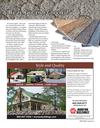022316_HOME_A 14.pdf



Dos and Don’ts of Kitchen Remodels
According to Remodeling
magazine’s 2014 Cost vs.
Value Report, a major kitchen
remodeling project should
enable homeowners to
recoup 74.2 percent of their
initial investments. Kitchen
renovations have long been
a safe way to improve the
functionality and value of a
home. But not every kitchen
project is a guaranteed
winner. Homeowners may
inadvertently make changes
that end up sticking out
like a sore thumb rather
than improving the space.
Take a look at these kitchen
remodeling dos and don’ts to
guide your next undertaking.
DO consider the way your
kitchen will look with the
rest of the home. Keep
architectural integrity in mind
when designing the space. A
farmhouse sink and country
cabinets can look out of place
in an ultra-modern home.
DON’T overlook the importance
of a seasoned designer or
architect. These pros will know
the tricks to maximizing space
and achieving the ideal layout
of appliances and may be able
to recommend local contractors
and vendors.
DO look beyond surface details
to the structural integrity of
the design. The kitchen should
be functional, long-lasting and
beautiful.
DON’T design just for today,
but look to the future as well.
Unless you are willing to spend
$50,000 every five years, look
for styles and materials that
will last for the long haul. Older
homeowners may want to
make adjustments now that
address potential mobility
issues down the road.
DO work with what you have.
A complete demolition and
renovation is not always
necessary to achieve the
desired results. Only invest in
major changes if something is
not working (such as having to
walk across the entire kitchen
to access the stove) or is unsafe.
Otherwise, minor upgrades
may do the trick.
DON’T over-improve the space.
A fully equipped commercial
kitchen may be handy for
a professional chef, but the
average person may not need
an industrial hood and indoor
pizza oven. When you make
excessive improvements, you
may not be able to recoup
as much of the money spent
because your home will not be
on par with the values of homes
in the neighborhood.
DO make sure you can afford
the project. Plan for some
unexpected purchases and plan
out the renovation according
to your budget. Skimping on
materials or design because of
lack of money may leave you
feeling dissatisfied afterward.
MetroCreative Connection
How to Create a Paver Walkway or Patio
Creating a walkway or patio out of paving
stones can add aesthetic appeal to a
property. Pavers are less permanent than
concrete and decking. As a result, it is easier
to change the design later on if you want to
give the space a new look.
Homeowners who install their own pavers
can save a considerable amount of money.
Because installing paving stones can be
labor-intensive, landscape contractors may
charge a premium for installation. However,
this is a project that can be tackled by the
do-it-yourselfer.
1. Measure and plot out the area that will
become the path or patio. The area of the
space can be figured out by multiplying
length times width. This will help you
determine just how much material you will
need.
2. Visit the home improvement store or
a supplier of stone and other masonry
supplies to determine the style and color
of the paving stones you will use in the
project. Some homeowners prefer to have
the materials delivered to their home to
14 TODAY’S HOME - Spring 2016
save the hassle of extra heavy lifting and
leave only the smallest gap between them.
moving.
7. Spread more paving sand on top of the
3. Using a shovel or a tiller, dig down and
paving stones and, using a broom, sweep
remove the grass to a depth of four to six
it over the stones and into the crevices
inches from the area that will become the
between them to set the stones.
path or patio.
8. Create the rest of the garden design
4. Fill in the area you dug out with a paver
around the patio or pathway using gravel,
base material, using a tamper (either
plants and even edging material to finish
manual or power-driven) to tamp down the the look. Over time you may need to sweep
paver base until it is level and smooth.
more paving sand over the stones to keep
5. Apply about one inch of paving sand to
them secure.
MetroCreative Connection
further level out the path or patio. This will
be the material on
which the paving
stones are laid.
6. Begin laying the
paving stones. Leave
Great Home Insurance
the appropriate
Protect your home with the best. And do it at a
distance between
price that will have your wallet saying “thanks” too.
stones desired by
Like a good neighbor, State Farm is there.”
your pattern. If
the paving stones
Roy Wilcox Agent
will not have any
200 W 4th ST
Yankton, SD 57078
gap and serve as a
Bus: 605-665-7140
continuous patio,
roy.d.wilcox.b6fp@statefarm.com
If your walls could talk,
they’d thank you




























 Previous Page
Previous Page





